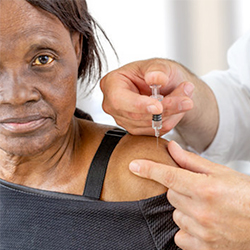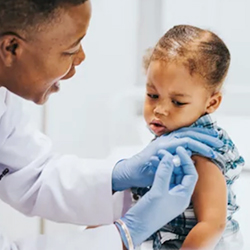SEATTLE—A global “info-demic” has resulted in the spread of dis- and misinformation, especially surrounding vaccines, according to data presented at the 2023 CROI meeting.
“We know that communication is fundamental to what we do,” Scott Ratzan, MD, the editor-in-chief of the Journal of Health Communication and a professor of public health at the CUNY School of Public Health & Health Policy and Columbia University Mailman School of Public Health, in New York City, told Infectious Disease Special Edition. “No matter what we do in the lab, in the field or as we communicate with the public and professionals, what’s most important is that we get it right, and we get it to the people at the right time for when they can use the information.”
According to the latest UNICEF data, an estimated 30 million children are behind on routine vaccines. Dr. Ratzan said there is a critical need to develop more effective communication strategies surrounding proven vaccines, such as HPV, diphtheria and pertussis.
“How do we rebuild the CDC’s credibility, the World Health Organization’s credibility, the state health department, the physician who’s overseeing an academic health center or even a local practice? Every one of us have a role to play.”
—IDSE News Staff
Video Transcript:
Hello, I’m Dr. Scott Ratzan. I’m editor of the Journal of Health Communication, and a professor of public health based at CUNY School of Public Health, and also at Columbia Mailman School of Public Health, in New York.
Over the years, frankly, for 27 years, I’ve been editing the Journal of Health Communication. And we know that communication is fundamental to what we do, no matter what we do in the lab, in the field or as we communicate with the public and professionals. What’s most important is that we get it right, and we get it to the people at the right time for when they can use the information.
Unfortunately, as we know, we have an ‘info-demic,’ an info-demic with infodemiologists trying to figure out what’s wrong. But yet, I’m on the side of what do we do that’s right. How do we get the strategies in place to get people to understand what we’re doing in the lab, what we’re doing in the field? And frankly, what we’re doing in the clinics and all of our ways that we actually practice public health gets diffused, disseminated and utilized by people.
So, the work that we’ve been doing is addressing misinformation or disinformation. Misinformation is a lot of the work, unfortunately, is done by people sometimes unknowingly, to spread false or misleading, or, frankly, lies or things that are not facts.
Disinformation, oftentimes, is by an external source, such as a government or a group that’s really working in propaganda. And now, even though we’re all here at CROI, at the scientific conference, what we really know is that people don’t just trust scientists, and they, frankly, don’t just trust government scientists as much as we might like.
We know from both the Edelman Trust Barometer, as well as surveys that we’ve been doing at CUNY School of Public Health, that academics are reviewed very highly by health professionals and business—one’s employer—where people get health information. And what we’ve been focusing on during this COVID pandemic, is how people get information and make decisions about vaccines.
Now, we know that there has been a large field that’s developed with Professor Heidi Larson, who’s also speaking at the panel with me here on vaccine hesitancy. Heidi has worked on vaccine confidence, and that’s really where I work with her and others, where we can create something called Convince, which is a coalition for new vaccine information, communication and engagement.
And the reason we’ve done this is that we know that people need to understand what vaccines do, how they work, and what they can do to protect themselves and have expectations for how it’s going to make our world a better place, supporting communities and so forth. We know that there’s been vaccines that have been successful, of course, with smallpox eradication, close to where we are with polio, and of course, limiting childhood infectious disease.
Unfortunately, though where we are now in February 2023, is we have a decline in routine vaccinations for children not only in the United States but globally. And the UNICEF data, most recently showing 30 million [children], or it may be even more, behind on vaccines that could, frankly, have presented and could prevent so many future morbidity and mortality. Shall I just go right to deaths? But also, the whole idea of bringing vaccines into the right place, such as HPV vaccine for preventing cancer years away. And all of these need different communication strategies.
If there’s an infectious disease where we know we need to prevent something tomorrow, people will be more apt to wear their mask, take whatever measures are in place, social distance and avoid the infectious agent, if they’re so lucky. Of course, we don’t always have that with vector-borne diseases, but we can do that with avoiding mosquitoes and so forth.
But yet we have these [vaccines]—long-term HPV preventing cervical cancer, others that are preventing what people haven’t even seen in our lifetimes, whether it’s diphtheria, pertussis and so forth. We need to do better.
And we’ve also worked with [Convince] to create Business Partners to Convince, where businesses also are taking an active role to get their employees and their leadership vaccinated not only for seasonal flu, which is important for avoiding absenteeism, also productivity of business continuity, and so forth, but also for COVID and also for their families.
Business Partners to Convince has a whole website with seven learning modules that have been in place that businesses can use. And that’s what we’re talking about here in our presentations is how we integrate what we know from communication.
So how do we rebuild the CDC’s credibility, the World Health Organization’s credibility, the state health department, the physician who’s overseeing an academic health center or even a local practice? Every one of us have a role to play.




